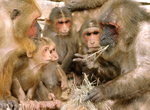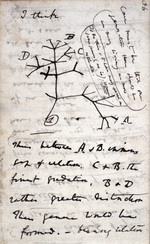poor color vision. Exceptions occur for some marsupials (which possibly kept their original color vision) and some primates—including humans. Primates, as... 9 KB (1,083 words) - 12:10, 4 January 2024 |
 | The evolutionary history of the primates can be traced back 57-90 million years. One of the oldest known primate-like mammal species, Plesiadapis, came... 21 KB (2,264 words) - 11:47, 11 March 2024 |
 | complex history of evolution in different animal taxa. In primates, color vision may have evolved under selective pressure for a variety of visual tasks... 64 KB (7,831 words) - 19:37, 14 April 2024 |
 | Trichromacy (redirect from Trichromatic theory of color vision) Pentachromacy Mantis shrimp (dodecachromats) Evolution of color vision in primates Young–Helmholtz theory LMS color space "Color Glossary". Archived from the original... 14 KB (1,585 words) - 08:43, 2 April 2024 |
 | Cat senses (redirect from Vision in cats) Jacobs, GH (12 October 2009). "Evolution of colour vision in mammals". Philosophical Transactions of the Royal Society of London. Series B, Biological Sciences... 20 KB (2,385 words) - 01:45, 15 March 2024 |
 | Olfactory receptor (redirect from Evolution of olfactory receptors) protein-coding OR genes. The vision priority hypothesis states that the evolution of color vision in primates may have decreased primate reliance on olfaction... 36 KB (4,348 words) - 09:10, 18 December 2023 |
 | Dog anatomy (redirect from Dog vision) of yellows, blues and grays, but they have difficulty differentiating between red and green, making their color vision equivalent to red–green color blindness... 55 KB (6,712 words) - 04:44, 19 April 2024 |
 | of color vision – Origin and variation of colour vision across various lineages through geologic time Evolution of color vision in primates – Loss and... 26 KB (4,699 words) - 11:05, 28 February 2024 |
that while primates may not possess morality in the human sense, they do exhibit some traits that would have been necessary for the evolution of morality... 25 KB (3,056 words) - 22:36, 19 March 2024 |
 | Simian (redirect from Higher primates) The simians, anthropoids, or higher primates are an infraorder (Simiiformes /ˈsɪmi.ɪfɔːrmiːz/) of primates containing all animals traditionally called... 21 KB (1,711 words) - 10:47, 8 April 2024 |
 | Monkey (redirect from Monkeys in mythology) monkeys, but strepsirrhine primates (suborder Strepsirrhini). The simians' sister group, the tarsiers, are also haplorhine primates; however, they are also... 49 KB (4,529 words) - 20:09, 21 April 2024 |
 | Tetrachromacy (redirect from Ultraviolet vision) opsins. Dimensionality of color vision Monochromacy Dichromacy Trichromacy Evolution of color vision Infrared vision RG color space RGBY Somatosensory... 24 KB (2,684 words) - 14:02, 13 April 2024 |
Dichromacy (redirect from Dichromatic color vision) evoked with a combination of monochromatic light and white light. Dichromacy in humans is a color vision deficiency in which one of the three cone cells is... 15 KB (1,711 words) - 22:04, 25 April 2024 |
including: primates, cetaceans, and birds. Primates and birds can pass information of specific tool use strategies on to their offspring who can, in turn,... 16 KB (2,052 words) - 05:17, 19 March 2024 |
 | Animal coloration (redirect from Animal color) (1874). The Descent of Man. Heinemann, London. Miller, G. F. (2000). The Mating Mind: How sexual choice shaped the evolution of human nature. Heinemann... 48 KB (5,262 words) - 23:25, 27 March 2024 |
Visual perception (redirect from Theory of vision) through photopic vision (daytime vision), color vision, scotopic vision (night vision), and mesopic vision (twilight vision), using light in the visible spectrum... 38 KB (4,572 words) - 04:35, 5 March 2024 |
 | Cathemerality (section Evolution of cathemerality) compared to diurnal primate vision systems. Cathemeral primates exhibit a vision system that is intermediate of diurnal and nocturnal primates, which suggests... 14 KB (1,596 words) - 07:43, 13 September 2023 |
 | Squirrel monkey (section Colour vision) thresholds. Color vision studies have also been performed on squirrel monkeys for the purpose of better understanding vision ailments in humans. The common... 23 KB (2,653 words) - 02:19, 6 April 2024 |
 | Lemur (redirect from Olfactory communication in lemurs) Primates in Perspective (2nd ed.). Oxford University Press. ISBN 978-0-19-539043-8. Hartwig, W. (2011). "Chapter 3: Primate evolution". Primates in Perspective... 175 KB (18,648 words) - 11:29, 11 April 2024 |
 | Catarrhini (category Taxa described in 1812) Retrieved 2020-09-08. Seiffert, Erik R. (2007). "Evolution and Extinction of Afro-Arabian Primates Near the Eocene-Oligocene Boundary". Folia Primatologica... 25 KB (2,311 words) - 02:10, 17 April 2024 |
 | Visible spectrum (redirect from Color spectrum) Helmholtz in the early 19th century. Their theory of color vision correctly proposed that the eye uses three distinct receptors to perceive color. The visible... 34 KB (3,899 words) - 23:31, 15 April 2024 |
novelty that first evolved in the common ancestor of the Old World Primates. Our trichromatic color vision evolved by duplication of the long wavelength sensitive... 35 KB (4,102 words) - 13:45, 28 April 2024 |
 | Evolution is the change in the heritable characteristics of biological populations over successive generations. It occurs when evolutionary processes... 238 KB (24,700 words) - 04:40, 1 April 2024 |
 | Red (redirect from List of terms associated with the color red) cannot see the red color of the cape of a bullfighter, but they are agitated by its movement. (See color vision). One theory for why primates developed sensitivity... 106 KB (12,074 words) - 19:45, 26 April 2024 |






